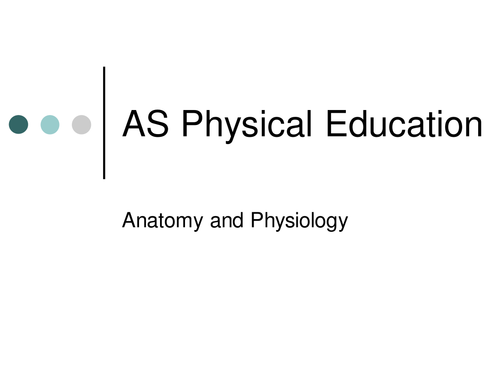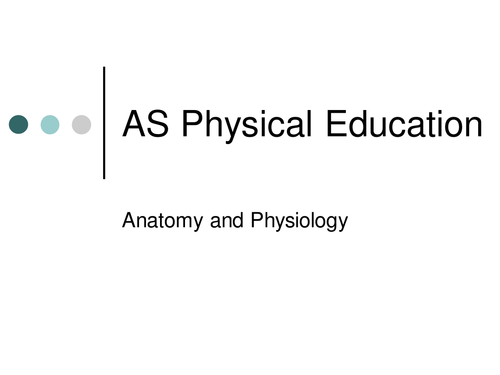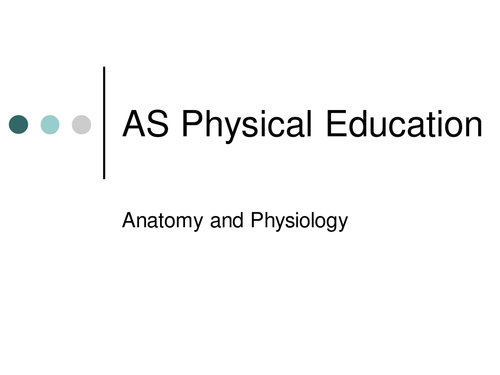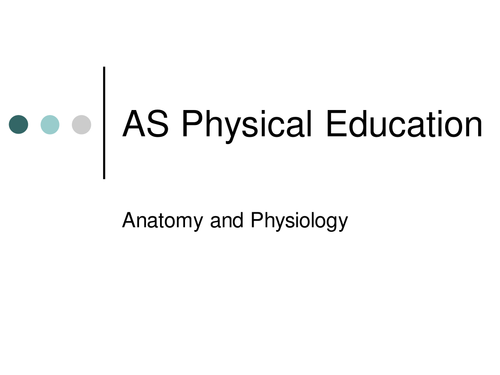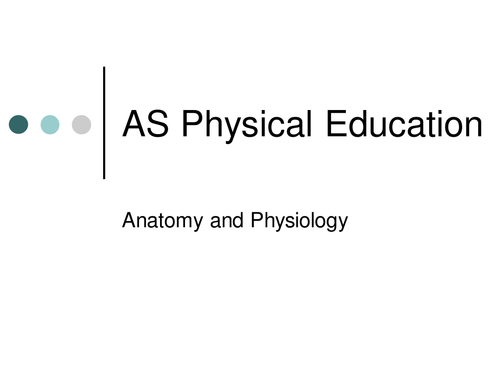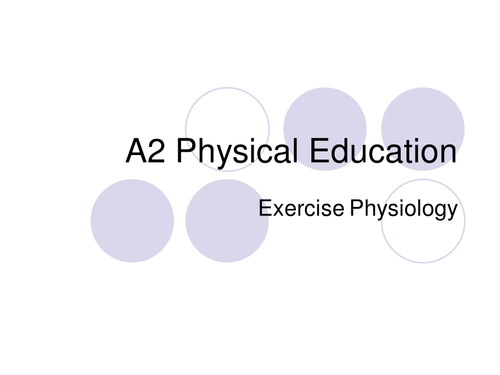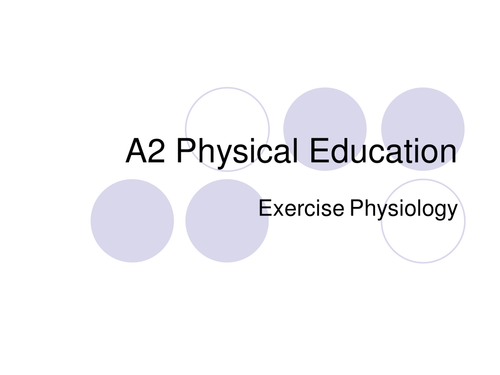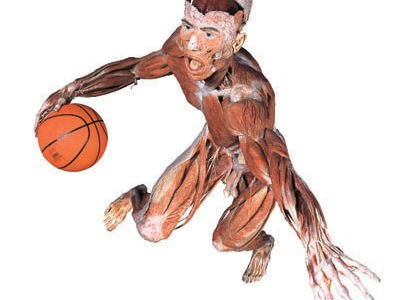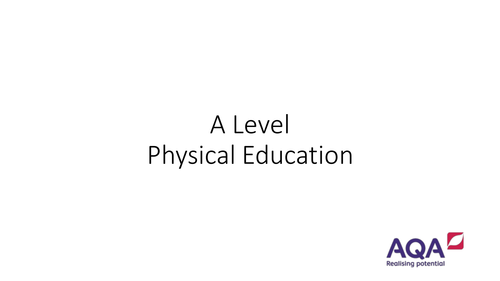
118Uploads
37k+Views
4k+Downloads
All resources
Sale

A level PE - Muscular Contractions
A Level Anatomy and Physiology lesson. Learning objectives:
- Identify the different types of Muscular Contraction.
- Relate these types of Muscular Contraction to physical activity.
- Perform a number of exercises which utilise the different types of Muscular Contraction.
Sale

A Level PE - Movement Analysis
A Level Anatomy and Physiology lesson. Learning objectives:
- Recap the types of movement possible at joints.
- Relate these types of movement to physical activity.
- Complete a full movement analysis of a discrete skill.
Sale

A Level PE - Joint Stability
A Level Anatomy and Physiology lesson. Learning objectives:
- Complete an analysis of joints in relation to joint stability.
- Identify the reasons for poor alignment and posture.
Sale

A level PE - Heart Rate, Stroke Volume and Cardiac Output
A Level Anatomy and Physiology lesson. Learning objectives:
- Describe the relationship between stroke volume, heart rate and cardiac output.
- Explain the changes that take place to stroke volume, heart rate and cardiac output during different intensities of physical activity.
Sale

A level PE - Heart Conduction System and Cardiac Cycles
A Level Anatomy and Physiology lesson. Learning objectives:
- Provide an overview of the Conduction System.
- Describe how the heart works as a dual action pump (Cardiac Cycle, diastole and systole).
- Describe the link between the Cardiac Cycle and the Conduction System of the heart.
Sale

A Level PE - Blood Pressure & Effects on the Vascular System of a Warm Up and Cool Down
A Level Anatomy and Physiology lesson. Learning objectives:
- Identify the effects on the vascular system of a warm-up and cool-down.
- Define blood pressure and identify resting values.
- Explain the changes that occur to blood pressure during physical activity and hypertension.
Sale

A Level PE - The Impact of Different Types of Physical Activity on the Cardiovascular System
A Level Anatomy and Physiology lesson. Learning objectives:
- Evaluate the impact of different types of physical activity on the cardiovascular system.
- Identity four types of cardiovascular disease.
- Investigate common cardiovascular diseases with reference to lifelong involvement in an active lifestyle.
Sale

A Level PE - Oxygen and Carbon Dioxide Transport
A Level Anatomy and Physiology lesson. Learning objectives:
You are to create an A3 poster which informs the reader about the below
points. Your target audience has no previous knowledge of this topic so
the poster must be very informative. Use page 57 in your notebook and
pages 87-88 as guidance in your textbook however, other resources will
need to be used.
Poster Content:
Describe how carbon dioxide and oxygen are carried within the vascular system.
Identify how effective transportation of carbon dioxide and oxygen within the vascular system aids participation in physical activity
Explain how smoking affects the transportation of oxygen.
Sale

A level PE - Energy Systems & ATP
A Level Exercise Physiology lesson. Learning objectives:
- Describe the breakdown and re-synthesis of ATP.
- Introduce the three energy systems used to supply ATP to working muscles.
- Explain how duration and intensity of exercise for relates to each energy systems.
Sale

A Level PE - Energy, Work and Power & ATP
A Level Exercise Physiology lesson. Learning objectives:
- To define the terms ‘energy’, ‘work’ and ‘power’.
- Identify examples of potential, chemical and kinetic energy.
- Introduce ATP.
Sale

Assembly - Teamwork and Expectations of a New Academic Year
I often use this assembly for the first assembly of the new academic year. In the first section of the assembly I talk about how this is the 'first day a new journey'. How students can remodel them self if they would like to this year of continue the good work from the previous year or years.
I then talk about the basic expectations of the year. Uniform expectations, behavioral expectations and such like.
The final section of the assembly is a practical that students really love but takes some preparation. One a table at the front of the assembly hall I sit a bowl of sweets on a table. I also selotape a spoon to a meter long ruler to create a meter long spoon! You will need two of these. I ask for two volunteers to come out and hand them a meter long spoon each. I tell the volunteers that they have 1 minute to eat as many sweets as possible however, there is one condition. They can only hold the meter long spoon by then end. The only way that they will be able to eat the sweets is to feed each other.
Once the demonstration is done I talk to the year group about how this is an example of being a team and that at school we have to help each other to make sure we succeed. I use the acronym to finish the assembly:
T - together
E - everyone
A - acheives
M - more
Sale

Rugby Union Quiz Wet Weather PE Lesson
This resource contains a quiz with 20 questions based on the rules and tactics of rugby union. I use this for wet weather lessons when teaching rugby union. Examples of question are:
1. What is a scrum?
2. What does a hooker do in a rugby team?
Sale

Assembly - Mental Health Awareness, Facts, Tips and Support
This assembly is centred around mental health awareness and I used this during the national childrens' mental health awareness week.
I open the assembly with a definition of mental health and the #timetotalk which I explain is the key message of the assembly. I also show a gif which says 'mental health is real, even if you cannot see it' and use the example of being able to see someone is is physically injured for instance on crutches however, you cannot see a mental health illness or injury.
The next section of the assembly is a short video about talking about mental health and how this is no longer a taboo subject and is something that as a school community we are aware of and support.
The next section of the assembly identifies that there are over 200 forms of mental health illness and I use three quiz questions to show how big of an issue this is nationally.
The final section of the assembly contains a number of helpful tips to maintain good mental health. I then finish the assembly with the national statistic that 'Nearly three in four young people fear the reactions of friends when they talk about their mental health problems'. I conclude by saying that as a school and house community we are here to support each other and that mental health is not a taboo subject and one which we accept.
Bundle Sale

A Level PE, Lesson Bundle, Respiratory System, Altitude & Gaseous Exchange
Respiratory system based lessons.
Student workbook with exam questions and mark schemes is also included plus the tasks associated with each lesson.
Bundle Sale

A Level PE, Lesson Bundle, Muscular and Skeletal Systems and Movement Analysis
Muscular and Skeletal Systems, Movement Analysis based lessons
Student workbook with exam questions and mark schemes is also included plus the tasks associated with each lesson.
Sale

A Level PE - The Golden Triangle, Sport and Social Media
Lesson Objectives:
Introduce the ‘Golden Triangle’ and the interrelationship between commercialisation, media and sponsorship.
To explore how the ‘Golden Triangle’ influences the development of sport in modern day society.
Identify what social media is and the impact it has on sport.
Sale

A Level PE - Sport Psychology, Attitudes
Learning Objectives
Introduce the triadic model and the different components of attitudes.
Understand the formation of different attitudes.
Able to explain and justify changing attitudes through cognitive dissonance and persuasive communication.
Sale

A Level PE, Sport Psychology, Anxiety
Learning Objectives
Define and identify somatic, cognitive, competitive trait and competitive state anxiety.
Understand and explain the advantages and disadvantages of using observations, questionnaires and physiological measures to measure anxiety.
Be able to apply and justify the impact of different types of anxiety on sport performance.
Sale

A Level PE, Sport Psychology, Arousal
Learning Objectives
Introduce the Drive Theory, Inverted U Theory, Catastrophe Theory and Zone of Optimal Functioning Theory.
Understand the characteristics of Peak Flow Experience .
Able to explain and justify the practical applications of theories of arousal and their impact on performance.
Sale

British Values - Mutual Respect and Tolerance
This assembly focuses on one of the British Values with regards to Mutual Respect and Tolerance.
The first slide is a definition of respect “A regard for the feelings, wishes, or rights of others”.
The next slide asks the students to compare and contrast the sports football and rugby with regards to the respect shown by both the players and spectators. This should spark debate about the respect and possible lack of respect shown in each. The following slides show footballers abusing referees and and then an article detailing how many referees are leaving football due to the abuse that they take.
A short video of a rugby referee then follows this which demonstrates how rugby players generally show great respect for the referee as he tells off 30 men who were not following the rules without any of them questioning him in any way.
The next two slides show a recent Manchester football derby where the police had to create a line to keep the fans away from each other. The next slide shows two rugby fans stood together at a game shouting on their teams.
This is the hook into the theme of mutual respect because why does rugby seem to have a culture of respect whilst football does not? I then explain that when people show each other respect this makes for a happier experience for all people involved.
I then ask the students how can we show respect for each other at our school and within our house to make it a nice place to be? I have broken this up into respecting yourself, respecting the environment and then others. Whilst talking about respecting others I then introduce the term mutual respect and explain why this is important. This leads into discussion about that fact that in Britian we live in a diverse nation made up of many different cultures, languages, races, and backgrounds and how we can learn from others.
I then finish the assembly with a golden rule about mutual respect: Treat others as you want to be treated

